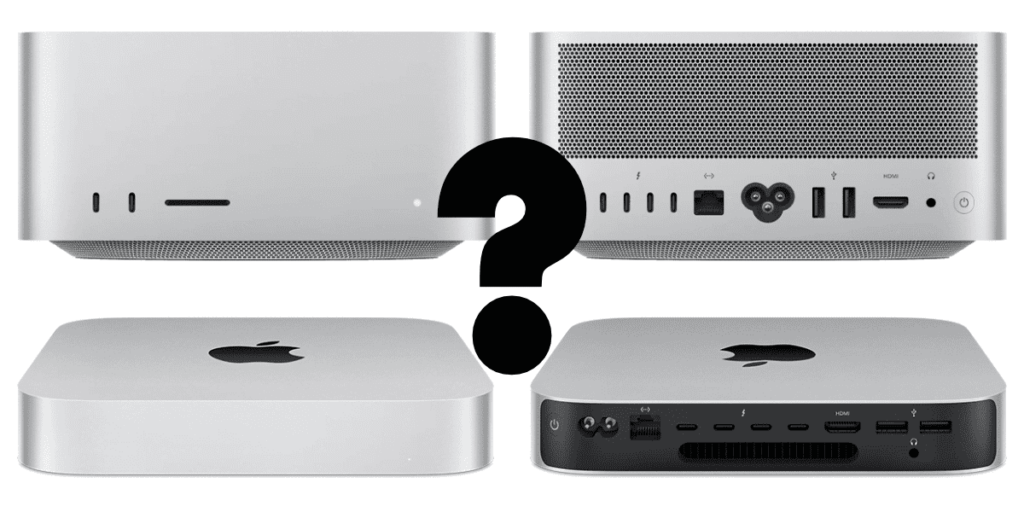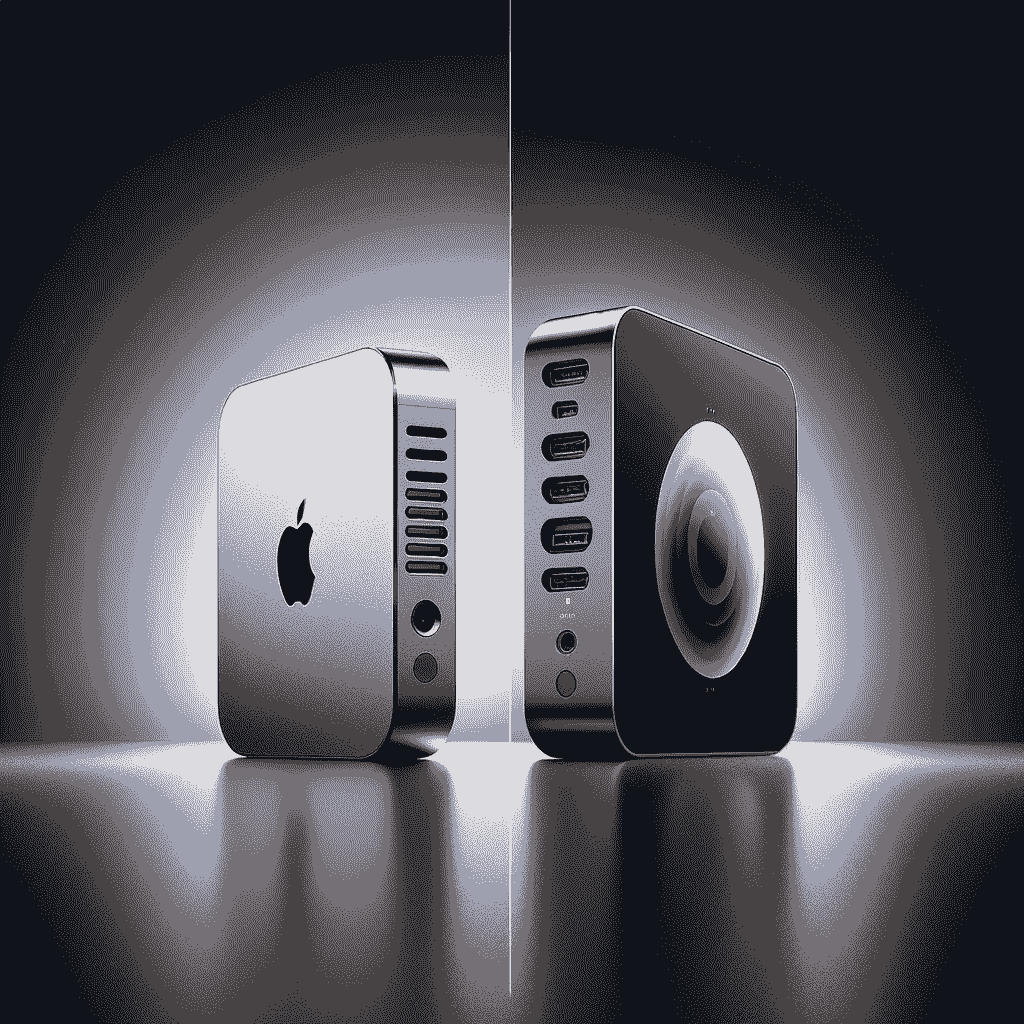In the world of desktop computing, Apple’s Mac Mini and Mac Studio stand out as two of the most discussed options, particularly among professionals and creatives. This review will dissect the differences and similarities between these devices, focusing on their performance, expandability, and suitability for various user needs. Apple’s innovative silicon chips – M2, M2 Pro, M2 Max, and M2 Ultra – are at the heart of these machines, offering a range of capabilities for different workflows. We’ll explore the nuances of these models in terms of pricing, specifications, port availability, and overall value, providing insights to guide your decision in selecting the best fit for your professional or personal computing needs.
Mac Studio vs Mac mini M2 Pro: Price
The pricing spectrum of the Mac Mini and Mac Studio reflects their target audiences and capabilities. The Mac Mini, starting at a more accessible price point, appeals to a broader audience, including home users and professionals on a budget. Its affordability doesn’t compromise on power, especially in the M2 and M2 Pro variants, making it a cost-effective solution for everyday computing and moderate creative tasks. On the other end, the Mac Studio is priced significantly higher, targeting professionals and power users who require top-tier performance. The higher-end configurations with M2 Max or M2 Ultra chips cater to intensive tasks like 4K and 8K video editing, complex 3D rendering, and large-scale data processing. This price difference becomes more pronounced as you customize the machines, with added RAM and storage options further widening the gap. For users whose work demands unparalleled processing power, the investment in a Mac Studio is justifiable. However, for those with more general computing needs or lighter creative tasks, the Mac Mini offers an excellent balance of performance and value.
Mac Studio vs Mac mini M2 Pro: Specs
Delving into specifications, the Mac Mini and Mac Studio are tailored for different user groups. The Mac Mini, available with the latest M2 and M2 Pro chips, is impressively powerful for its compact size. It handles general computing tasks with ease and is capable of managing more demanding applications like photo editing and casual video editing. The M2 chip brings notable improvements in CPU and GPU performance over its predecessors, while the M2 Pro offers even more power and efficiency, suitable for more intensive tasks.
In contrast, the Mac Studio is a behemoth in terms of specs. With options for M2 Max and M2 Ultra chips, it stands as a pinnacle of desktop computing power, designed for professionals who need the best. The M2 Max and M2 Ultra elevate performance to new heights, particularly in GPU capabilities, making them ideal for high-end video editing, 3D animation, and software development. Geekbench 5 scores consistently illustrate the superior performance of the Mac Studio, showcasing its prowess in handling multi-core processes and graphics-intensive tasks.
Furthermore, the Mac Studio excels in memory and storage options. With higher memory capacities and faster memory bandwidth, it can smoothly handle large files and multitasking with ease. This is particularly beneficial for professionals working with large datasets, high-resolution video files, or complex 3D models. The Mac Mini, while offering decent memory options, doesn’t quite match the Mac Studio’s capacity, making it more suitable for less memory-intensive tasks.
Mac Studio vs Mac mini M2 Pro: Ports
Ports are a vital aspect of any desktop computer, particularly for professionals who need to connect multiple devices and displays. Both the Mac Mini and Mac Studio offer a range of ports, but the Mac Studio takes the lead in terms of quantity and versatility. It features multiple Thunderbolt/USB 4 ports, an SDXC card slot, and additional connectivity options, catering to a wide range of peripherals from high-speed storage devices to professional-grade monitors. This expandability is essential for creatives and professionals who rely on a multitude of external devices for their work.

In terms of external display support, both models offer robust options. The Mac Mini can comfortably drive multiple displays, making it a suitable choice for standard office setups or content creation. However, for those requiring more extensive display setups, such as video editors or graphic designers, the Mac Studio’s ability to support numerous high-resolution displays simultaneously is a game-changer. Its compatibility with Apple’s Studio Display further enhances the user experience, offering a seamless and integrated workflow within the Apple ecosystem.
Mac Studio vs Mac mini M2 Pro: Buying Advice (150 words)
Your choice between the Mac Mini and Mac Studio should hinge on your specific needs and budget. For everyday users and professionals with moderate performance requirements, the Mac Mini stands out as an excellent choice, offering a balance between cost and capability. It’s ideal for tasks like office productivity, light photo and video editing, and general multimedia consumption.
On the other hand, the Mac Studio is tailored for power users and professionals whose work demands the highest levels of performance and expandability. Its advanced configurations with M2 Max and M2 Ultra chips are particularly suited for tasks like professional video editing, 3D rendering, and software development. For those considering future-proofing their setup or seeking even more power, the Mac Pro with the M1 Ultra chip is another option to explore.

Comparison of Mac Mini and Mac Studio: Features, Performance, and Price Considerations
| Criteria | Mac Mini | Mac Studio |
|---|---|---|
| Price & Display Consideration | Pairing an M2 Pro Mac Mini with an Apple Studio Display costs $2,898. | A base model Mac Studio alone costs $1,999. An M2 Ultra Mac Studio with no display costs $3,999. |
| Performance | High-level performance and versatility at a comparatively low price. | Extreme multi-core CPU or GPU performance. |
| Size | Smaller desktop machine. | Larger, more stationary desktop machine. |
| Memory | Standard memory options, typically up to 32GB. | Supports more than 32GB of memory and high memory bandwidth. |
| Ports | Standard port options, usually up to four Thunderbolt/USB 4 ports. | More than four Thunderbolt/USB 4 ports. |
| Display Support | Supports fewer external displays compared to Mac Studio. | Support for more than three external displays. |
| Additional Features | – | Includes a built-in SDXC card slot (UHS-II). |
| Budget Consideration | Savings on the desktop computer can be used for a good external display, like the Studio Display. | Higher initial investment, potentially offering more power and features for professional-grade tasks. |
Summary
Apple’s Mac Studio and Mac Mini are two desktop Mac options for users who do not need the expandability of the Mac Pro. The Mac Studio is more expensive, starting at $1,999, but offers extreme multi-core CPU or GPU performance, more than 32GB of memory and high memory bandwidth, more than four Thunderbolt/USB 4 ports, support for more than three external displays, and a built-in SDXC card slot (UHS-II). The Mac Mini, on the other hand, is more affordable, starting at $599, and offers a high-level of performance and versatility at a comparatively low price. The decision to purchase should be driven by budget and specific workflow needs.
